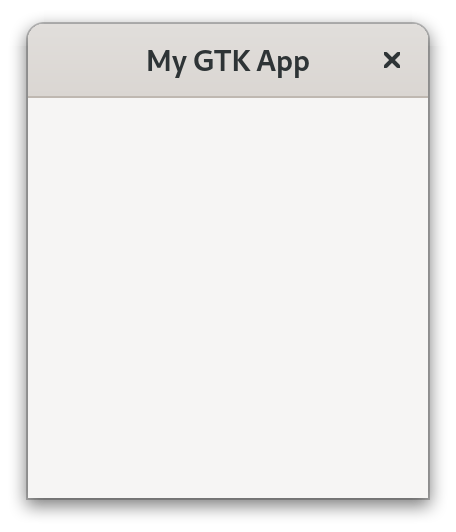Hello World!
现在我们已经安装好了,让我们开始吧!
至少,我们需要创建一个带有应用程序 ID 的 gtk::Application 实例。 为此,我们使用了许多 gtk-rs 对象都支持的 builder 模式。 请注意,我们还导入了 prelude 以将必要的 trait 引入。
文件名:listings/hello_world/1/main.rs
use gtk::prelude::*;
use gtk::{glib, Application};
const APP_ID: &str = "org.gtk_rs.HelloWorld1";
fn main() -> glib::ExitCode {
// Create a new application
let app = Application::builder().application_id(APP_ID).build();
// Run the application
app.run()
}它构建正常,但终端中显示一条警告。
GLib-GIO-WARNING: Your application does not implement g_application_activate()
and has no handlers connected to the 'activate' signal. It should do one of these.
GTK 告诉我们,应该在其 activate步骤中调用某些内容。
所以让我们在那里创建一个 gtk::ApplicationWindow。
文件名:listings/hello_world/2/main.rs
use gtk::prelude::*;
use gtk::{glib, Application, ApplicationWindow};
const APP_ID: &str = "org.gtk_rs.HelloWorld2";
fn main() -> glib::ExitCode {
// Create a new application
let app = Application::builder().application_id(APP_ID).build();
// Connect to "activate" signal of `app`
app.connect_activate(build_ui);
// Run the application
app.run()
}
fn build_ui(app: &Application) {
// Create a window and set the title
let window = ApplicationWindow::builder()
.application(app)
.title("My GTK App")
.build();
// Present window
window.present();
}这样好多了!

通常,我们希望用户能够与界面进行交互。
此外,章节的名称表示软件将包含 “Hello World!”。
文件名:listings/hello_world/3/main.rs
use gtk::prelude::*;
use gtk::{glib, Application, ApplicationWindow, Button};
const APP_ID: &str = "org.gtk_rs.HelloWorld3";
fn main() -> glib::ExitCode {
// Create a new application
let app = Application::builder().application_id(APP_ID).build();
// Connect to "activate" signal of `app`
app.connect_activate(build_ui);
// Run the application
app.run()
}
fn build_ui(app: &Application) {
// Create a button with label and margins
let button = Button::builder()
.label("Press me!")
.margin_top(12)
.margin_bottom(12)
.margin_start(12)
.margin_end(12)
.build();
// Connect to "clicked" signal of `button`
button.connect_clicked(|button| {
// Set the label to "Hello World!" after the button has been clicked on
button.set_label("Hello World!");
});
// Create a window
let window = ApplicationWindow::builder()
.application(app)
.title("My GTK App")
.child(&button)
.build();
// Present window
window.present();
}如果您仔细查看这段代码,您会注意到它的右上角有一个小眼睛符号。 按下它后,您可以看到完整代码。 我们将在整本书中使用它来隐藏那些对传达信息并不重要的细节。 如果您想按照本书一步步编写程序,请注意这一点。 在这里,我们隐藏了我们引入
gtk::Button的内容。
现在有一个按钮,如果我们单击它,它的标签将变为 “Hello World!”。
创建我们的第一个 gtk-rs 应用程序不是很难,对吧? 现在让我们更好地了解我们到底在这里做了什么。